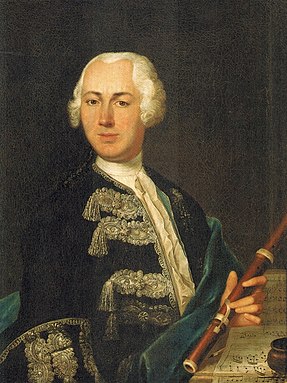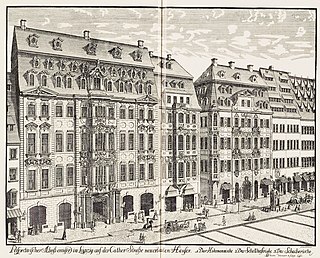Related Research Articles

Carl Philipp Emanuel Bach, also formerly spelled Karl Philipp Emmanuel Bach, and commonly abbreviated C. P. E. Bach, was a German Classical period musician and composer, the fifth child and second surviving son of Johann Sebastian Bach and Maria Barbara Bach. His second name was in honor of his godfather Georg Philipp Telemann, a friend of Johann Sebastian Bach.

Johann Joachim Quantz was a German composer, flutist and flute maker of the late Baroque period. Much of his professional career was spent in the court of Frederick the Great. Quantz composed hundreds of flute sonatas and concertos, and wrote On Playing the Flute, an influential treatise on flute performance. His works were known and appreciated by Bach, Haydn and Mozart.
The trio sonata is a genre, typically consisting of several movements, with two melody instruments and continuo. Originating in the early 17th century, the trio sonata was a favorite chamber ensemble combination in the Baroque era.

Wilhelm Friedemann Bach, the second child and eldest son of Johann Sebastian Bach and Maria Barbara Bach, was a German composer and performer. Despite his acknowledged genius as an organist, improviser and composer, his income and employment were unstable and he died in poverty.

Johann Christoph Friedrich Bach was a harpsichordist and composer, the fifth son of Johann Sebastian Bach, sometimes referred to as the "Bückeburg Bach".
Empfindsamkeit or Empfindsamer Stil is a style of musical composition and poetry developed in 18th-century Germany, intended to express "true and natural" feelings, and featuring sudden contrasts of mood. It was developed as a contrast to the Baroque Affektenlehre, in which a composition would have the same affect throughout.
This is a list of notable events in music that took place in the year 1735.

In music, a trio is any of the following:
Ars Rediviva was a Czech classical instrumental music group, whose historically-informed performances played a key role in the revival of Baroque music in Czechoslovakia.

The Sonata in G major for two flutes and basso continuo, BWV 1039, is a trio sonata by Johann Sebastian Bach. It is a version, for a different instrumentation, of the Gamba Sonata, BWV 1027. The first, second and fourth movement of these sonatas also exist as a trio sonata for organ.

Friedrich Wilhelm Rust was a German violinist, pianist and composer. He hailed from a renowned musical family in Germany. He was the father of the pianist and organist Wilhelm Karl Rust and the grandfather of Thomaskantor, composer and Bach scholar Wilhelm Rust.
The Orchestral Suite in G minor, BWV 1070 is a work by an unknown composer. It is part of the Bach-Werke-Verzeichnis catalogue of the works of J. S. Bach, and sometimes called the "Orchestral Suite No. 5", but was almost certainly not composed by him. It is more likely that the composer was his son W. F. Bach. It is a French suite with an overture and several dances, which has a similar structure with the 4 orchestral suites known to have been written by J. S. Bach. Evidence for its not being by the older composer includes the form of the opening movement, which differs from that used in the suites known to be by him, and the fact that the third movement is in a different key to the rest of the work, whereas J. S. Bach's suites are homotonal.

The six sonatas for violin and obbligato harpsichord BWV 1014–1019 by Johann Sebastian Bach are works in trio sonata form, with the two upper parts in the harpsichord and violin over a bass line supplied by the harpsichord and an optional viola da gamba. Unlike baroque sonatas for solo instrument and continuo, where the realisation of the figured bass was left to the discretion of the performer, the keyboard part in the sonatas was almost entirely specified by Bach. They were probably mostly composed during Bach's final years in Cöthen between 1720 and 1723, before he moved to Leipzig. The extant sources for the collection span the whole of Bach's period in Leipzig, during which time he continued to make changes to the score.

The sonatas for viola da gamba and harpsichord, BWV 1027–1029, are three sonatas composed by Johann Sebastian Bach for viola da gamba and harpsichord. They probably date from the late 1730s and early 1740s.

The organ sonatas, BWV 525–530 by Johann Sebastian Bach are a collection of six sonatas in trio sonata form. Each of the sonatas has three movements, with three independent parts in the two manuals and obbligato pedal. The collection was put together in Leipzig in the late 1720s and contained reworkings of prior compositions by Bach from earlier cantatas, organ works and chamber music as well as some newly composed movements. The sixth sonata, BWV 530, is the only one for which all three movements were specially composed for the collection. When played on an organ, the second manual part is often played an octave lower on the keyboard with appropriate registration. Commentators have suggested that the collection might partly have been intended for private study to perfect organ technique, some pointing out that its compass allows it to be played on a pedal clavichord. The collection of sonatas is generally regarded as one of Bach's masterpieces for organ. The sonatas are also considered to be amongst his most difficult compositions for the instrument.
The Triple Concerto, BWV 1044, is a concerto in A minor for traverso, violin, harpsichord, and string orchestra by Johann Sebastian Bach. He based the composition on his Prelude and Fugue BWV 894 for harpsichord and on the middle movement of his Organ Sonata BWV 527, or on earlier lost models for these compositions.

The organ concertos of Johann Sebastian Bach are solo works for organ, transcribed and reworked from instrumental concertos originally composed by Antonio Vivaldi and the musically talented Prince Johann Ernst of Saxe-Weimar. While there is no doubt about the authenticity of BWV 592–596, the sixth concerto BWV 597 is now probably considered to be spurious. Composed during Bach's second period at the court in Weimar (1708–1717), the concertos can be dated more precisely to 1713–1714.
References
- 1 2 Sadie, Stanley, ed. (2001). The New Grove Dictionary of Music and Musicians . 2. Oxford University Press. pp. 383, 386. ISBN 978-0-19-517067-2.
- ↑ Schulenberg, David (2010). The Music of Wilhelm Friedemann Bach (Eastman Studies in Music). University of Rochester Press. p. 308. ISBN 978-1-58-046359-1.
- ↑ CBS Masterworks MK 37813, and Sony SMK 64509: with John Steele Ritter, harpsichord, and Leslie Parnas, cello.